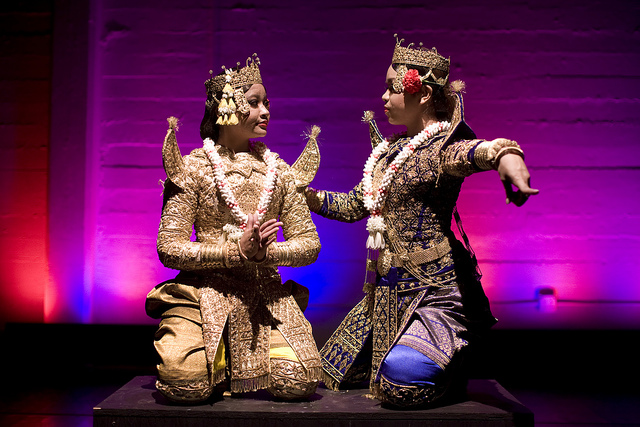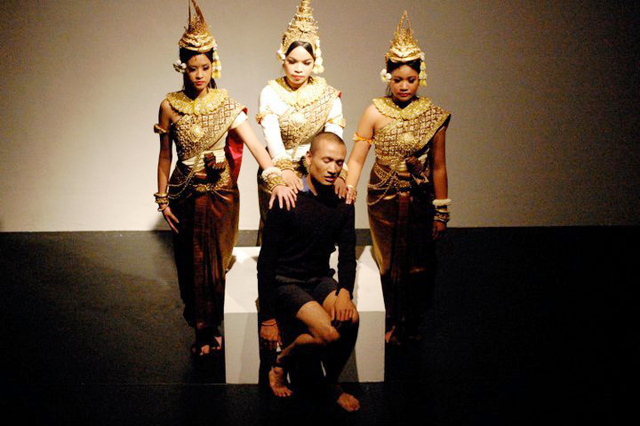I’d like to begin by expressing my gratitude to the Alliance for California Traditional Arts, a most important organization whose many programs work to ensure the life and growth of art forms that are marginalized, art forms that carry rich histories and philosophies that have yet to see their full play in our society.
As a former apprentice to Charya Burt in ACTA’s Apprenticeship Program, it is with great honor and responsibility that I return to it as a “master artist.” First off, I feel that this title is not yet mine to claim. I am still learning from my loving teachers Neak Kru Sophiline and Neak Kru Poy (Penh Yom) and I am a relatively new practitioner when considering the amount of training required for a classical art form. However, I am well-aware that I am one of the art form’s most-knowledgeable carriers in the Greater Los Angeles area and I must do all that I can to train and mold, challenge and nurture the next generation of Cambodian classical dance artists.

Khannia (left) and Sophanmay Nong, Khmer Arts Academy Artist-in-Residence, in my original work Robam Santhyea Vehea at CounterPULSE in San Francisco. Photo by Jon Rivera.
I could not be working with my youngest sister Khannia at a more crucial time. Our father — the foundation of our family — recently passed away from cancer. He told me countless times before his death that I must take care of my sister. Even more, Khannia is a senior in high school who is getting ready to leave home for college where she will find her own adventures and direct her own path. It is through this program and more that I intend to give her my love, share with her the gifts that I have been given, and equip her with a foundation and vocabulary in which to explore and respond to the world around her.
This comes at no easy task.
Much of the dialogue surrounding the practice of Cambodian classical dance in America relates to cultural preservation. Thus, what you often get are students who come to practice, either forced by their parents or on their own will, in order to “connect with [their] culture.” And too often, this “culture” means ethnic identity. For many of these people, face, pride, and routine are more than enough — skill and accuracy, history and vision seem to be of little importance.
This is unlike someone who is working as an artist: someone who understands the form as a medium in which to engage and shape their world, someone who sees and lives the philosophy and way of being ingrained in the gestures and choreographic structures, someone who is committed to sharing the richness of this heritage with as many people as possible, through as many forms as possible. It is the unique visions of individual artists — some whose names are no longer remembered, some whose contributions have faded to obscurity, some currently working and pushing boundaries — that, when combined, create the appearance of a collective heritage and knowledge we call tradition.
Khannia has the potential to be one of these artists in the tradition of Cambodian classical dance, an art form developed over a thousand years ago as a prayer-in-movement for the deliverance of health and harmony, life and fertility, renewal and regeneration.
Since the beginning of her training, she was one of Neak Kru Sophiline’s most promising students. She remembered choreography quickly; her technique was advanced. She even out-performed those who were her seniors in age and training. I often watched Neak Kru Sophiline struggle to place Khannia amongst a group of bodies that seemed to tower over her. And I remember so clearly a day when Sam Sathya, perhaps Cambodia’s leading performer of female roles, leaned over to me to say, “Prum, Khannia is very good. She can star in Cambodia.” Years later, Khannia demonstrates this same skill and edge through a spiritual maturity and weight that manifests so beautifully in her movement.

Khannia (far right) and I (seated), with my student Reachny Tan (far left) and Sophanmay Nong (center) in my original work, The Cambodia Exhibit, at Highways Performance Space in Santa Monica. Photo by Leo Garcia.
I am excited to be working with my sister, exploring ideas such as emotional presence and gestural vocabulary, dissecting characters of the dance and examining history in a manner that many in the “community-oriented” model of practice find too demanding and intense. I want Khannia to be more than a hobbyist because she is capable of more than that. And if not an artist working in this language, she can be someone who keeps it alive by translating its essence and core into other forms and someone who is guided and inspired by the ideas inherent in it.
Just the way my teacher Neak Kru Sophiline has touched and transformed my life through this venerable art, I hope to do the same for Khannia. And slowly, but surely, a community of post-first generation artists — people who are true voices and carriers of this art and science, this philosophy and magic — will emerge to uphold the integrity of this art form, growing its capacities and meanings in California, Cambodia, and abroad.
Thank you ACTA, for this wonderful opportunity and challenge.
